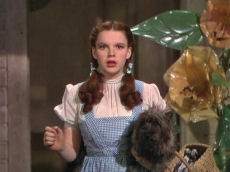Risky Biz blog’s Anne Thompson has chided David Denby‘s recently posted New Yorker piece about Hollywood’s digital future by calling it a dutiful “term paper” that seems “terribly familar” and “very obvious…and as always, Denby’s sorry to let the old ways go.”
I enjoyed Denby’s piece because it’s honest and thorough and well written — he talked to many of the Left Coast people he needed to speak to and then tried to put it all together in his head, and then he came back to Manhattan and wrote it from his heart. It’s a smart, absorbing read. I don’t get the bashing. From Poland, yes (naturally)…but not from Anne.
And while digital technology is improving new and old films markedly (i.e., first-rate digital projection in theatres is, to my eyes, definitely preferable to film projection), some of the “old ways” of showing and experiencing movies were really spectac- ular. There’s an extra-oomph showmanship quality that’s missing from all but the best theatres (like Hollywood’s Arclight) today.
Those ornate, super-sized movie palaces, for example….finito. I’ve only seen pictures (okay, I was inside Radio City Music Hall once) but I feel like I’ve missed out on something really grandiose and spirit-filling.
I’ve seen 30-frame Todd-AO exactly once in my life (when a restored 30-frame version of Oklahoma! was shown in ’84 or thereabouts), and I’ve never forgotten it. The fluidity of motion and considerable lessening of pan blur in that ancient 70mm process, which hasn’t been freshly exhibited since 1956 or thereabouts, was truly awesome.
Something in me also regrets that Showscan, the 60 frame-per-second process that peaked iin the ’80s and early ’90s, was never used to make a feature film. I’m a little bit sorry also that the old three-projector Cinerama process, dual-projector 3-D projection, Ultra- and Super-Panavision 70, Camera 65, Dimension 150, Aromarama and all the nervy, forward-thinking processes of the ’50s and early ’60s are gone as well.
Day: January 3, 2007
Ebner vs. Cosby
Hollywood Interrupted‘s Mark Ebner is claiming that People magazine “recently buried” a rare investigative piece featuring shocking interviews with three women claiming that Bill Cosby “earned their trust, then sexually assaulted them,” but because the story was hidden in all the fluff that drives celebrity magazine sales, Cosby-as-serial sexual-abuser is still essentially a non-story.”
The ever-dogged Ebner, who dug into Cosby’s history while working for the Bonnie Fuller tabs, goes on to make his case that Cosby has been drugging and in some cases having his way with women for a fairly long time. I usually stay far away from stories of this kind, but I happen to be personally acquainted with a woman who told me (and eventually Ebner, whom I introduced her to) that she had an unwanted (i.e. forced) sexual encounter with Cosby in ’69. And I believe her.
The interesting thing here is how and why People bailed on this story, if in fact this happened. (I’ve inquired with a friend in People‘s West Coast office; maybe I’ll hear something back.) Cosby doesn’t even turn up when you do a search on their site.
Prior to Ebner’s story the strongest Cosby impression I’ve had over the last few years has been Jack Black‘s put-down of a sweater John Cusack wears in the first 20 minutes of High Fidelity: “It’s a Cosby sweater…a Cosby sweater!”
Ultra-Resolution Explained
Carly Mayberry‘s 1.3.07 Hollywood Reporter piece about the Warner Bros./AOL digital restoration process called Ultra-Resolution — which has been nominated for a Scientific and Technical Academy Award — describes it reverently but incompletely.


frame capture from 1999 Wizard of Oz restoration (l.) vs. 2002 Ultra-Resolution restoration (r.) [source: DVD Beaver]
I’ve been a devout worshipper of this process since seeing the results on the super-duper restored four-disc Gone With The Wind DVD (released in ’04), plus ones for The Wizard of Oz (released in October ’05), Singin’ in the Rain (’02) and The Searchers (released last June). The colors on these DVDs are heart-stop- pingly crisp and vibrant and luminous — they’re so pretty you could eat them.
Mayberry says Technicolor films like GWTW, Singin’ In the Rain and Oz — which over time have suffered (here comes the litany) slight blurrings, “color fringing”, “color breathing,” misregistration, detail lost during multiple generations of dupli- cation as well as shrinkage, stretching and other damage — have been realigned and made to look much sharper with by Ultra-Resolution, with the added bounty of much more vibrant colors.

But she doesn’t explain that what’s been realigned are the three color strips — cyan, yellow and magenta — that combine with a b&w negative to render the final images in the old Technicolor process. (The Searchers, which was filmed in a single-strip color process, was restored by realigning the separation masters.)
Nor does Mayberry explain that Ultra-Resolution makes these old films look sharper and cleaner than they ever looked to the people who made them back in the late 1930s (and, in Singin’ in the Rain‘s case, early ’50s). That’s because the late 1930s (and early ’50s) technology that aligned the three strips was less exacting than this relatively new digital process, which was created for AOL by Keren and Sharon Perlmutter.
Nor does she mention that some of the Ultra-Resolution imagery is so precise that viewers can see things that they’re not supposed to see, like the wires lifting up the Wizard of Oz flying monkeys. (I say keep the clarity and digitally erase the wires — simple and very common. Same solution for the far-too-vivid wires holding up the Martian space ships in War of the Worlds.)
Nor does she mention that Lowry Digital, which was bought a year and a half ago by DTS (Digital Theatre Systems), and Cinesite, the Los Angeles branch of which was shut down two and half or three years ago by Kodak, have developed very similar processes on their own, and applied them to various films.

